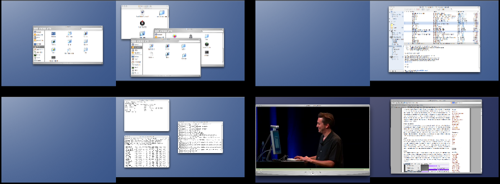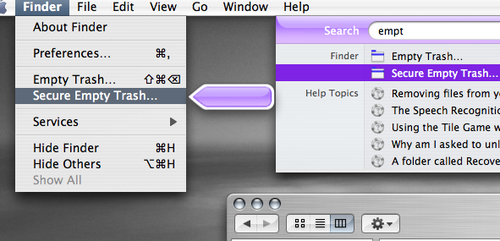I've been toying with leopard for a bit, and mostly I'm liking where OSX is going. Let's touch on the "big" things a bit, first.
Spaces
Very nice. I've been waiting for a proper implementation of Virtual Desktops on OSX and this seems to be it. There are still a few quirks to work out (like the order of apps in the cmd-tab switcher, the app you selected in the cmd-tab switcher not necessarily coming out in front if you need to switch desktops, etc.) but I'm sure that'll all be fine. I'm hooked already. And this wasn't mentioned in the keynote, but exposé still works if you have the 'spaces-exposé' (for lack of a better word) open: it'll do exposé on all your virtual desktops at once. Oh, and for those wondering what happens with multiple monitors: nothing special. You just get a virtual desktop shaped like the combined desktops of your screens, like so:

Time Machine
Also nice. The restore-interface is the supreme of weird right now, and while it looks very flashy (and slightly sluggish on my 2GHz core duo!) I do hope they do something better with this. Lots of people have been coming up with lots of theories on how Time Machine works, but it appears to just be a periodic incremental backup that appears as a snapshot on disk. That is, you get an entire filesystem that you can restore, but it only takes up the space of a full backup + the changed data. Not sure how this is done yet, as leopard will only show me real files but I suppose some symlink-like trick is pulled.
The two big things here were Stationeries and Notes (and related, todos). I can't get excited about stationeries at all. I don't like HTML e-mail and I never will, and that is just what stationeries are. I suppose for corporate communication of companies that don't mind bloaty HTML in their e-mail, this will make adding the company style to e-mail a lot easier though. Notes/Todos I do see becoming useful. However, the aesthetics need to be rethought. I've managed to change the font but not the background colour.
Help
Not mentioned but very nice in my opinion is the new Help system. The old Help menu was just that: a menu with some pointers to where you might find help. It got a bit of an overhaul. The new menu includes a search field that you type a term or phrase in. If that term or phrase happens to result in a menu, the help system will open that menu for you and point you at the relevant item. So we know what I'm talking about here, a screenshot:

Yes, it's purple. I'm sure (well, I hope) that'll change.
iChat
The photobooth effects were included but aren't really anything new. Unfortunately, backdrops and iChat Theater weren't included in this preview. Would've been fun but it can wait. Update: iChat Theater isincluded, at least for sharing quicktime movies. It's activated by choosing 'Share with iChat' in the quicktime player's View menu, rather than doing something in iChat itself.
The Small Things
Apple improved on a lot of small things that aren't really worth mentioning in any sort of keynote, but that do make life in OSX a lot easier. In no particular order, I've found so far:
- Safari has incorporated Taboo. That is, it'll warn you if you try to close a window with multiple tabs. (Finally!)
- Safari has gained find-as-you-type. Gone is the search window, it has made place for something a bit more like the Firefox search bar.
- Sort of mentioned, but Spotlight no longer highlights 'show all', instead opting for the Top Hit. Makes it much faster for app-launching.
- Mail's address auto-complete now also works with the 'Nickname' field of Address Book contacts.
- For those who like it, Exposé (all windows) and Spotlight can be added to the dock with a launcher app, like dashboard in Tiger.
- Safari can now undo tab-closes. Closed a tab by accident? Cmd-z and it's right back where it was.
- Preview now allows annotating (ovals and text) images and pdfs, as opposed to just pdfs.
- Mail now allows you to set the dock icon's Unread badge to either just the inbox or all mailboxes.
- There is now a dedicated Guest account, the contents of which's home directory get deleted on logging out.
Background technologies
Tiger set the road for some UI stuff that Leopard expands on. For one, the resolution-independent UI. While, at least in this preview, it isn't finished yet, you can see progress being made. Some widgets will now scale up if you set the scaling factor (it can't scale down anymore, it seems). The Dock immediately knows about this when you change it, and some icons (like Time Machine, iChat and Safari) will scale to insane sizes. Quartz 2D Extreme seems to have been renamed QuartzGL. It isn't enabled by default yet, but Quartz Debug does allow you to turn it on and save that setting.
Daily use?
Is it ready for daily use yet? No. Well, not if you don't mind losing whatever data you were working on a lot or saving every five sentences. Safari crashed twice as I wrote this post, and I've seen the crashreporter dialog pop up a few times in other apps, too. It's still preview software, though, so I guess I can't complain. If only I could port Spaces to Tiger...